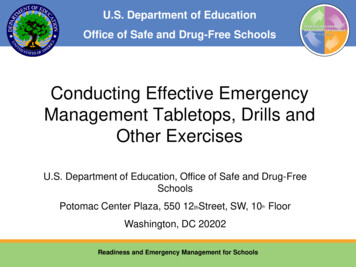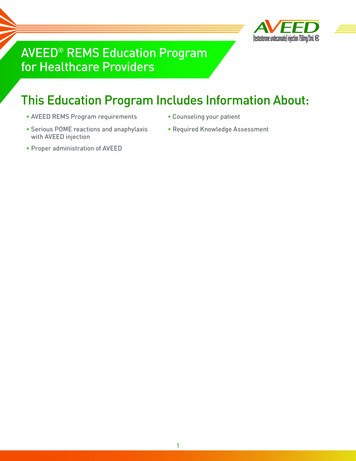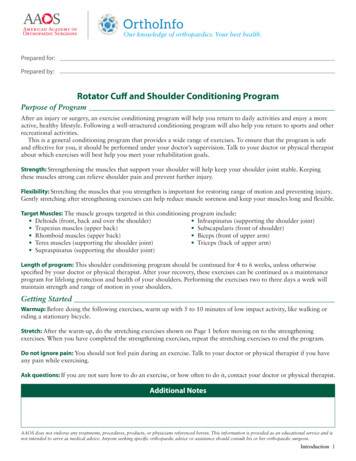
Transcription
U.S. Department of EducationOffice of Safe and Drug-Free SchoolsConducting Effective EmergencyManagement Tabletops, Drills andOther ExercisesU.S. Department of Education, Office of Safe and Drug-FreeSchoolsPotomac Center Plaza, 550 12thStreet, SW, 10 FloorthWashington, DC 20202Readiness and Emergency Management for Schools
Presentation GoalsI.II.Discuss why schools should conduct emergency exercisesConnect exercises to the four phases of emergencymanagement (Prevention-Mitigation, Preparedness,Response and Recovery)III. Overview of five types of emergency exercisesIV. Suggest community and federal support resourcesV.Discuss how to build a successful exercise designcontinuumVI. Share best practices in conducting exercisesVII. Conduct an interactive activityVIII. Highlight exercise safety proceduresIX. Discuss after-action reviewsX.Share common exercise mistakesXI. Provide resources for further planningU.S. Department of Education Office of Safe and Drug-Free Schools2
Presentation GoalsI.Discuss why schools should conductemergency exercisesU.S. Department of Education Office of Safe and Drug-Free Schools3
I. Why Schools Should ConductEmergency Exercises1.Clarify roles and responsibilities2.Evaluate plans and procedures3.Develop effective agency relationships4.Assess resources and capabilities5.Identify needs and solutions6.Provides significant benefits to school and community7.States have legislation requiring school exercises and drillsMany emergency management agencies and other accredited public safetyagencies must conduct various types of exercises on an annual basis.U.S. Department of Education Office of Safe and Drug-Free Schools4
I. Why Schools Should ConductEmergency Exercises (Cont'd.) Most states require by law a specific number of fire drills tobe conducted in schools, often on a monthly basis. Several states mandate schools to hold lockdown drillsseveral times per year (e.g., Alabama, Minnesota, RhodeIsland), while others recommend the practice (e.g., Arkansas,Georgia, Illinois). According to a June 2007 General Accounting Office (GAO)report, Emergency Management: Most School Districts HaveDeveloped Emergency Management Plans, but Would Benefitfrom Additional Federal Guidance (GAO-07-609), a nationalsurvey of school districts showed an estimated 73 percentregularly conduct a drill or exercise to prepare for emergencysituations relating to evacuation, lockdown, or shelter-in-place.U.S. Department of Education Office of Safe and Drug-Free Schools5
I. Why Schools Should ConductEmergency Exercises (Cont'd.) Some states require schools hold other types of drills: Shelter-in-place drills once per year (e.g., Arizona, Illinois)or Duck, cover, and hold drills quarterly (e.g., California) Extreme weather drills twice per year (e.g., Alabama) Tornado drills quarterly (e.g., Arkansas) or yearly (e.g.,North Carolina, Virginia) Earthquake drills monthly (e.g., Hawaii) Crisis response drills once per year (e.g., Delaware) Bomb drills twice per year (e.g., Georgia) Bus evacuation drills once per year (e.g., Illinois) Other states leave the prescription of drills entirely to thelocal or school district level (e.g., Florida, Colorado).U.S. Department of Education Office of Safe and Drug-Free Schools6
I. Why Schools Should ConductEmergency Exercises (Cont'd.)The benefits are clear: Greater consistency of response More efficient use of resources Increased confidence in students,staff and parents Stronger relationships with partnersU.S. Department of Education Office of Safe and Drug-Free Schools7
I. Why Schools Should ConductEmergency Exercises (Cont'd.)An AlarmistAComplacentIndividualEveryone Should Be HereProactive Liability ManagementU.S. Department of Education Office of Safe and Drug-Free Schools8
I. Why Schools Should ConductEmergency Exercises (Cont'd.)A key to effective emergency response in schools is exercising thebalance between flexibility and consistency that is best developedthrough an exercise design continuum.FlexibilityGood JudgmentConsistencyEstablish trustDevelop knowledgePractice the planTimeBuild relationshipsU.S. Department of Education Office of Safe and Drug-Free Schools9
Presentation GoalsI.II.Discuss why schools should conductemergency exercisesConnect exercises to the four phases ofemergency management (PreventionMitigation, Preparedness, Response andRecovery)U.S. Department of Education Office of Safe and Drug-Free Schools10
II. Connect Exercises to the FourPhases of Emergency ManagementExercises are a core element of thePreparedness phase of emergencymanagement; however, an effectiveexercise program impacts eachphase of the cycle.Prevention-MitigationPreparednessExercises: Point out vulnerabilities to address inthe Prevention-Mitigation phase. Allow partners to practice a Responsethat can help ensure a smooth andefficient response in an actual crisis. Demonstrate what resources may beneeded during the Recovery phase.RecoveryResponseU.S. Department of Education Office of Safe and Drug-Free Schools11
Presentation GoalsI.Discuss why schools should conductemergency exercisesII. Connect exercises to the four phases ofemergency management (PreventionMitigation, Preparedness, Response andRecovery)III. Overview of five types of emergency exercisesU.S. Department of Education Office of Safe and Drug-Free Schools12
III. Types of Emergency Exercises1.2.3.4.5.Orientation Sessions: Inform about emergency operationsplans and emergency procedures (lasts one to two hours,takes two or more days to plan)Drills: Perfect an individual emergency procedure (lasts 30min. to two hours, takes up to three days to plan)Tabletop Exercises: Identify roles/responsibilities indifferent scenarios (lasts one to four hours, takes one ormore months to plan)Functional Exercises: Roundtable simulation of emergencysituation with realistic timeline (lasts three to eight hours,takes three months to plan)Full-scale Exercises: Multiagency, on-site simulation of anemergency situation; all resources deployed (lasts multipledays, takes six or more months to plan)U.S. Department of Education Office of Safe and Drug-Free Schools13
III. Types of Emergency Exercises(Cont’d.)FULL-SCALE EXERCISEFUNCTIONAL EXERCISEResources DeployedStressful Simulated EventsDRILLTABLETOPSingle ProcedureGroup DiscussionORIENTATION SESSIONGetting Everyone on BoardU.S. Department of Education Office of Safe and Drug-Free Schools14
III. Types of Emergency Exercises:Orientation SessionWhat is an orientation session? Orientation sessions are the initial meeting to discuss atopic or a problem in a group setting and introduce allpotential participants to the exercise continuum processas well as emergency response procedures. An orientation session is: A low-stress, informal discussion with little or (typically) nosimulation; Similar to many briefings that school personnel conduct ona variety of topics; and Comparable to seminars held by emergency managementagencies.U.S. Department of Education Office of Safe and Drug-Free Schools15
III. Types of Emergency Exercises:Orientation Session (Cont'd.)Why hold an orientation session? Introduce something new (i.e., policies and plans, emergencyoperations center, etc.) Explain existing plans, procedures, and updates tostakeholders Introduce a multi-event continuum to prepare participants andstakeholders for success in more complex exercises Motivate people for participation in subsequent exercises Identify those who are critical of the need to plan for andpractice emergency situations and, if appropriate, involvethem Emphasize emergency management link to school mission,money, Annual Yearly Progress, and community responsibilityU.S. Department of Education Office of Safe and Drug-Free Schools16
III. Types of Emergency Exercises:Orientation Session (Cont'd.)Who is involved in an orientation session? School administration The school or district’s emergency response team andpotentially the Incident Commander and/or general staff ofthe school’s Incident Command System Lead facilitator Stakeholders: Teachers, support staff, substitute teachers; Students, if appropriate; Parent groups, if appropriate; and Local emergency response agency representatives or other keyexternal partners.U.S. Department of Education Office of Safe and Drug-Free Schools17
III. Types of Emergency Exercises:Orientation Session (Cont'd.)What is needed to conduct an orientation session? A facility with minimal distractions Specific outcome goals for the session A clear justification for why the school will be engaging in theupcoming drills and exercises Explicit support from school and district administration A realistic timeline for upcoming exercise activities as well asexplanation of how these will impact instructional time Description of agencies involved and what their roles will be Presentation materials Advanced consideration for how to address skeptics’ concernsor challengesU.S. Department of Education Office of Safe and Drug-Free Schools18
III. Types of Emergency Exercises:Tabletop ExerciseWhat is a tabletop exercise? A tabletop exercise is a facilitated analysis of anemergency situation in an informal, stress-freeenvironment. Tabletops should be designed to elicit constructivediscussion as participants examine and resolve problemsbased on existing operational plans and identify wherethose plans need to be refined.U.S. Department of Education Office of Safe and Drug-Free Schools19
III. Types of Emergency Exercises:Tabletop Exercise (Cont'd.)Why conduct a tabletop exercise? Provides opportunity for low-stress discussion ofcoordination and policy within the school and/or betweenthe school and other agencies Offers a good environment for problem solving Provides an opportunity for key agencies andstakeholders to become acquainted with one another,their interrelated roles, and their respectiveresponsibilities Promotes good preparation for a functional exerciseU.S. Department of Education Office of Safe and Drug-Free Schools20
III. Types of Emergency Exercises:Tabletop Exercise (Cont'd.)Who is involved with a tabletop exercise? The objectives of the exercise dictate who shouldparticipate. The exercise can involve many people and manyorganizations—but at a minimum, those performing keyresponse roles should be involved. A skilled, objective facilitator who can maintain groupfocus and constructive dialogue is vital. A scribe is helpful—as can be the reflections of“observers” from multiple agencies.U.S. Department of Education Office of Safe and Drug-Free Schools21
III. Types of Emergency Exercises:Tabletop Exercise (Cont'd.)What is needed for a tabletop exercise? A facility with minimal distractionsSpecific outcome goals for the exerciseFacilitator, participants, scribe, observers (optimal)Projector, flip chart, or boardRecords of previous orientation sessions and drills (are valuable)A short narrative, which sets the stage for the hypotheticalemergency Problem statements describing /summarize major or detailed eventsto keep the group focused—may be addressed either to individualparticipants or to participating departments or agencies Simulated messages that are interjected into the discussion to addadditional and necessary complexityU.S. Department of Education Office of Safe and Drug-Free Schools22
III. Types of Emergency Exercises:Tabletop Exercise (Cont'd.)Example: Phases of Tabletop DevelopmentPreplanning- Hazard analysis- Establish objectives- Inform the media- Orientation meetings- Set timelines- Identify participants- Pre-exercise training- Single-agency drillTabletop ExerciseAfter-Action- Identify a facilitator- Identify a scribe- Draft the narrative- Set time limits- Room layout- Breaks/refreshments- Presentation- Copies of materials- Sign-in sheet- Conduct the exercise- Immediate debriefing- Participant evaluation- Comprehensive report- Post-exercise meeting- Next steps- Lessons learned- Revisions- Training- ImplementationDeveloping a tabletop exercise takes more than one month toplan. The event typically lasts one to four hours.U.S. Department of Education Office of Safe and Drug-Free Schools23
III. Types of Emergency Exercises:Tabletop Exercise (Cont'd.)Sample School Tabletop Room LayoutScreenProjectorObserversU.S. Department of Education Office of Safe and Drug-Free Schools24
III. Types of Emergency Exercises: DrillWhat is a drill?A coordinated, supervised exercise activity, normally usedto test a single specific operation or function. Schools commonly conduct fireevacuation drills, but a comprehensiveapproach to emergency managementrequires practicing many otherprocedures as well (e.g., control ofinfectious disease, shelter-in-place,etc.), and under a variety of conditions.U.S. Department of Education Office of Safe and Drug-Free Schools25
III. Types of Emergency Exercises:Drill (Cont'd.)Why conduct a drill? To practice and perfect one small part of the responseplan To prepare for more extensive exercises in whichseveral functions will be coordinated and tested To focus on a single, relatively limited portion of theoverall emergency management system To practice and maintain current skills To provide training with new equipment To develop new policies or proceduresU.S. Department of Education Office of Safe and Drug-Free Schools26
III. Types of Emergency Exercises:Drill (Cont'd.)Who is involved in a drill?Participation is driven and limited by the nature of theresponse procedure being tested but may involve one ormore of the following groups: Administration; Teachers and support staff; Students; Parent and other communitygroups; and An emergency response agency.U.S. Department of Education Office of Safe and Drug-Free Schools27
III. Types of Emergency Exercises:Drill (Cont'd.)What is needed to conduct a drill? Clearly outlined, specific and measurable goals andobjectives for the drill. A general briefing session on the drill’s purpose. Advanced notification to parents, guardians, and thesurrounding community. Relevant equipment. An evaluator. After-action review meeting and report.U.S. Department of Education Office of Safe and Drug-Free Schools28
III. Types of Emergency Exercises:Drill (Cont'd.)Drill Considerations Coordinate with school and local public safety; have themobserve or participate Follow your district or school procedures Make the drills realistic, but do so safely Test warning and notification procedures Block normal routes to force staff to make criticaldecisions Plan for students, staff and visitors with special needs Test accountability procedures (use the visitor log or othersystems) Consider student release procedures during certain drills Debrief the same day with your teachers and staffU.S. Department of Education Office of Safe and Drug-Free Schools29
III. Types of Emergency Exercises:Functional ExerciseWhat is a functionalexercise? The functional exercisesimulates an emergency in themost realistic manner possible,short of moving real people,equipment, and resources to anactual site. As the namesuggests, its goal is to test orevaluate the capability of one ormore functions in the context ofan emergency event.U.S. Department of Education Office of Safe and Drug-Free Schools30
III. Types of Emergency Exercises:Functional Exercise (Cont'd.)Why conduct a functional exercise? Tests one or more functions andexercises of several agencies ordepartments without incurring thecosts of a full-scale exercise Tests multiple functions of the school /district's emergency management plan Simulates an incident in the mostrealistic manner possible short ofmoving resources to an actual site Is highly interactive, moderatelystressful, requires quick decision makingU.S. Department of Education Office of Safe and Drug-Free Schools31
III. Types of Emergency Exercises:Functional Exercise (Cont'd.)Who is involved in a functional exercise? Controller: Manages and directs the exercise Players: Respond as in a real emergency (should includepolicymakers; may include coordinators and operationalpersonnel directing field activities) Simulators: Assume external roles and deliver plannedmessages to the players Evaluators: Assess performance through observationU.S. Department of Education Office of Safe and Drug-Free Schools32
III. Types of Emergency Exercises:Functional Exercise (Cont'd.)What is needed to conduct a functional exercise?Setup Gather people where they would actually operate in anemergency Seat players and simulators in separate areas or rooms Achieve realism using telephones, radios, televisions,and maps Use carefully scripted and timed messages/“injects"U.S. Department of Education Office of Safe and Drug-Free Schools33
III. Types of Emergency Exercises:Full-scale ExerciseWhat is a full-scale exercise? A full-scale exercise is as close to a real crisis aspossible. It is a lengthy exercise which takes placeon location, using the equipment, personnel, andresources that would becalled upon in a real event.It typically tests multipleoperational components ofthe school’s emergency plan.U.S. Department of Education Office of Safe and Drug-Free Schools34
III. Types of Emergency Exercises:Full-scale Exercise (Cont'd.)Why conduct a full-scale exercise? Simulates a real event as closely as possible—the ultimate test offunctions Evaluates the operational capability of emergency managementsystems in a highly stressful environment that simulates actualresponse conditions Activates the ICS / EOC Coordinates the actions ofseveral entities Tests several emergency functions Is an excellent learning exercise Utilizes same personnel "roles" asfunctional exercise—but nowincludes “victims"U.S. Department of Education Office of Safe and Drug-Free Schools35
III. Types of Emergency Exercises:Full-scale Exercise (Cont'd.)Who is involved in a full-scale exercise? School staff Students Relevant district staff and board members Community partners Identify which organizations need to be involved to carry outthe functions being tested and which organizationalrepresentatives should be there First responders (police, fire, EMT) Emergency management agency (city, county, state) Parents/guardians EvaluatorsU.S. Department of Education Office of Safe and Drug-Free Schools36
III. Types of Emergency Exercises:Full-scale Exercise (Cont'd.)What is needed for a full-scale exercise? Time to plan—may require six to eight months todevelop a comprehensive, full scale exercise Completion of a logical sequence of the orientationsessions, drills, and functional exercises prior is key Involvement of media on scene A realistic location selectionU.S. Department of Education Office of Safe and Drug-Free Schools37
III. Types of Emergency Exercises:Full-scale Exercise (Cont'd.)What factors are needed for a full-scale exercise? Needs assessment Design team formation Scope, purpose, objective definitions on paper Scenario development Controller, evaluator, player, simulator identification Secure location for guests / observers (with audio & video if possible) Master scenario events list and message development Materials, supplies, enhancements, such as props Evaluation form development Prior execution of preliminary orientation, tabletop, drill, functional exercise Compiled media / parent information After-action review and then reportU.S. Department of Education Office of Safe and Drug-Free Schools38
III. Types of Emergency Exercises:Full-scale Exercise (Cont'd.)For a successful full-scale exercise:An objective is key Should describe performance expected from participants to demonstratecompetence Should be clear, concise, focused on participant performance Should state who should do what under what conditions according to whatstandardsStandardsWhoConditionsWithin 15 minutesafter the evacuation notice is given,members of the EOCwill complete notification procedures toschool administrators.Specific actionU.S. Department of Education Office of Safe and Drug-Free Schools39
Presentation GoalsI.Discuss why schools should conductemergency exercisesII. Connect exercises to the four phases ofemergency management (PreventionMitigation, Preparedness, Response andRecovery)III. Overview of five types of emergency exercisesIV. Suggest community and federal supportresourcesU.S. Department of Education Office of Safe and Drug-Free Schools40
IV. Support Resources Local Emergency Management Agency (LEMA) Local Public Safety Agencies School District Personnel School Resource Officer Local Emergency Planning Committee (LEPC)* State and Local Homeland Security Agencies Victim Services Faith-Based Organizations* A LEPC is a committee that is comprised of members from government, industryand elected officials who are involved in emergency planning activities in acommunity. Check with your local emergency manager.U.S. Department of Education Office of Safe and Drug-Free Schools41
IV. Support Resources (Cont'd.)U.S. Department of Homeland Security Exercise andEvaluation Program This is a program that promotes a national standard for HomelandSecurity exercises. It is focused on capabilities, performance, evaluation andimprovement planning. An evaluation program is a requirement to receive Department ofHomeland Security funding. Local and state public safety agencies will typically guide you throughthe process. More information, tool kit and templates available athttps://hseep.dhs.gov(The HSEEP site is a secure site—a password request may be sent tosupport@hseep.net to access resources.)U.S. Department of Education Office of Safe and Drug-Free Schools42
Presentation GoalsI.Discuss why schools should conductemergency exercisesII. Connect exercises to the four phases ofemergency management (PreventionMitigation, Preparedness, Response andRecovery)III. Overview of five types of emergency exercisesIV. Suggest community and federal supportresourcesV. Discuss how to build a successful exercisedesign continuumU.S. Department of Education Office of Safe and Drug-Free Schools43
V. Building a Successful ExerciseDesign Continuum1.2.3.4.5.6.7.8.9.10.Based on the needs assessment, elect one of your school’s mainvulnerabilitiesWith response agencies, set a date six to eight months in advance for afull-scale exercise based on that vulnerabilityDesignate a design team leader and exercise design team—or ensurethere is a central school liaison who is part of the external agency designteamFrom that date, back into an orientation sessionDetermine which procedures will be utilized in the full-scale exercise,then schedule a series of drills that separately address each oneAfter several such drills, schedule two to three tabletopsHold a functional exerciseExecute the full-scale exerciseHold after-action reviews throughoutImplement the evaluation results throughoutU.S. Department of Education Office of Safe and Drug-Free Schools44
Presentation GoalsI.Discuss why schools should conduct emergencyexercisesII. Connect exercises to the four phases ofemergency management (Prevention-Mitigation,Preparedness, Response and Recovery)III. Overview of five types of emergency exercisesIV. Suggest community and federal supportresourcesV. Discuss how to build a successful exercisedesign continuumVI. Share best practices in conducting exercisesU.S. Department of Education Office of Safe and Drug-Free Schools45
VI. Best Practices inConducting Exercises Practice a variety of different scenarios based upon risks in theschool and community: Utilize hazard / vulnerability data; and Collaborate with disaster and emergency services. Practice a variety of different response procedures, such aslockdown, shelter-in-place, evacuation. Communicate information in advance (with parents, media andsurrounding neighborhoods as appropriate). Evaluate and document lessons learned in an after-actionreport. Implement exercise outcome recommendations. Test the capacity of all agencies—not just schools.U.S. Department of Education Office of Safe and Drug-Free Schools46
VI. Best Practices inConducting Exercises (Cont'd.) Drill under different conditions (time, weather, pull keypeople such as the building engineer). Identify weaknesses and areas for improvement Build design succession of exercises to instill feelings of“success.” Make sure that one objective is to implement theIncident Command System to be compliant withNational Incident Management System and to betterintegrate with local response agencies. The goals of an exercise are NOT achieved UNTIL therecommendations from the after–action review areimplemented.U.S. Department of Education Office of Safe and Drug-Free Schools47
Presentation GoalsI.Discuss why schools should conduct emergencyexercisesII. Connect exercises to the four phases ofemergency management (Prevention-Mitigation,Preparedness, Response and Recovery)III. Overview of five types of emergency exercisesIV. Suggest community and federal support resourcesV. Discuss how to build a successful exercise designcontinuumVI. Share best practices in conducting exercisesVII. Conduct an interactive activityU.S. Department of Education Office of Safe and Drug-Free Schools48
VII. Interactive ActivityWork in groups: Identify a high-priority vulnerability. Using the exercise continuum: Define date, scenario, and key partners for a full scaleexercise; Determine procedures/functions that will be tested; Create a concise purpose for the event; and Map out three drills, one tabletop scenario and onefunctional exercise that address those functions.U.S. Department of Education Office of Safe and Drug-Free Schools49
Presentation GoalsI.Discuss why schools should conduct emergencyexercisesII.Connect exercises to the four phases of emergencymanagement (Prevention-Mitigation, Preparedness,Response and Recovery)III. Overview of five types of emergency exercisesIV. Suggest community and federal support resourcesV. Discuss how to build a successful exercise designcontinuumVI. Share best practices in conducting exercisesVII. Conduct an interactive activityVIII. Highlight exercise safety proceduresU.S. Department of Education Office of Safe and Drug-Free Schools50
VIII. Exercise Safety Procedures Conduct a safety briefing Establish a code word to cease the exercise Have “non-players” identified Establish a check-in area Designate a safety officer Mark observer/evaluator areas Obtain vests for observer/evaluators Identify weapons cleared for exercise Utilize “Exercise in Progress” signage Obtain radios for exercise control team Provide the media and nearby neighborhoods /business with pre- and post-event informationU.S. Department of Education Office of Safe and Drug-Free Schools5151
Presentation GoalsI.Discuss why schools should conduct emergencyexercisesII.Connect exercises to the four phases of emergencymanagement (Prevention-Mitigation, Preparedness,Response and Recovery)III. Overview of five types of emergency exercisesIV. Suggest community and federal support resourcesV. Discuss how to build a successful exercise designcontinuumVI. Share best practices in conducting exercisesVII. Conduct an interactive activityVIII. Highlight exercise safety proceduresIX. Discuss after-action reviewsU.S. Department of Education Office of Safe and Drug-Free Schools52
IX. After-action ReviewWhat is an After-action Review? After-action reviews capture key lessons learned fromemergency response and make recommendations forimprovements. Components of after-action reviews: Conduct exercise / emergency activities overview; Relevance of goals and objectives; Analysis of outcomes; Analysis of capacity to perform critical tasks; Recommendations; Specific improvements for each partner; and Accountability plan for follow-up.U.S. Department of Education Office of Safe and Drug-Free Schools53
IX. After-action Review (Cont'd.)Considerations for after-action reviews Best time for a review may not necessarily be immediately afterthe exercise is conducted A skilled facilitator is important Any tension amongst those present must be constructiveBenefits of after-action reviews Supports proactive response management Provides documentation for any future litigation Identifies areas for improvementU.S. Department of Education Office of Safe and Drug-Free Schools54
IX. After-action Review (Cont'd.)After-action reviews vs. “hot wash” After-action review: Term for a thorough debrief andevaluation after an event to capture key lessons learnedfrom emergency response and make recommendationsfor improvements. Hot wash: Term for a brief meeting shortly after an eventintended to capture major reflection or explanations ofactions.U.S. Department of Education Office of Safe and Drug-Free Schools55
Presentation GoalsI.Discuss why schools should conduct emergencyexercisesII.Connect exercises to the four phases of emergencymanagement (Prevention-Mitigation, Preparedness,Response and Recovery)III. Overview of five types of emergency exercisesIV. Suggest community and federal support resourcesV.Discuss how to build a successful exercise designcontinuumVI. Share best practices in conducting exercisesVII. Conduct an interactive activityVIII. Highlight exercise safety proceduresIX. Discuss after-action reviewsX.Share common exercise mistakesU.S. Department of Education Office of Safe and Drug-Free Schools56
X. Common Exercise Mistakes Scenarios are not unique or tailored to the local area. Scenarios are too complex for the Local EducationAgency (LEA) to manage successfully. Timing of the exercise is inadequate. No accurate critique of the exercise afterwards. Safety issues are not ad
3. Tabletop Exercises: Identify roles/responsibilities in different scenarios (lasts one to four hours, takes one or more months to plan) 4. Functional Exercises: Roundtable simulation of emergency situation with realistic timeline (lasts three to eight hours, takes three months to plan) 5. Full-scale Exercises: Multiagency, on-site simulation .










